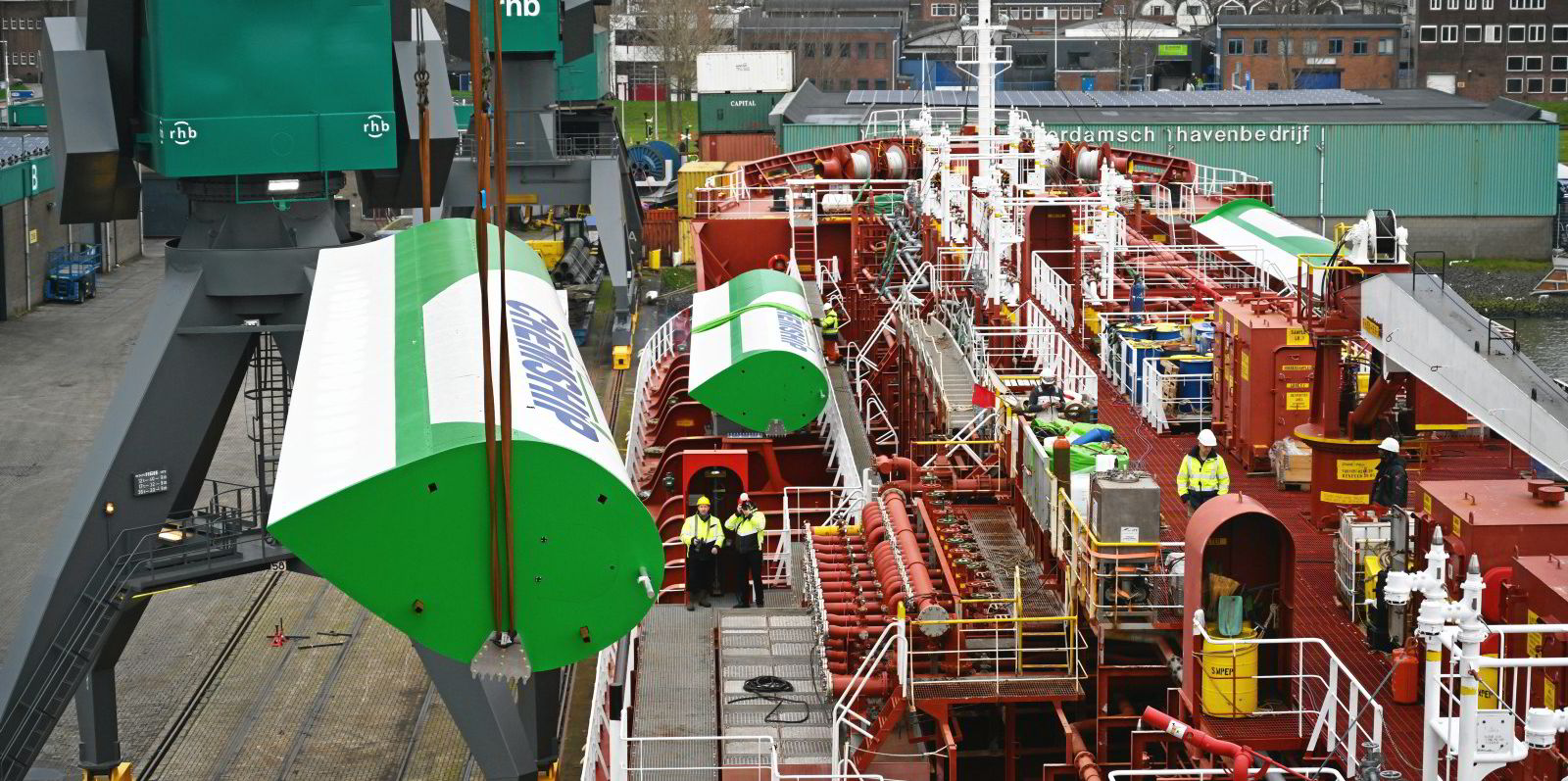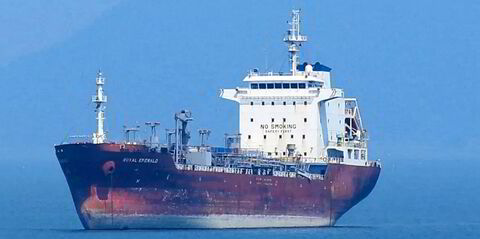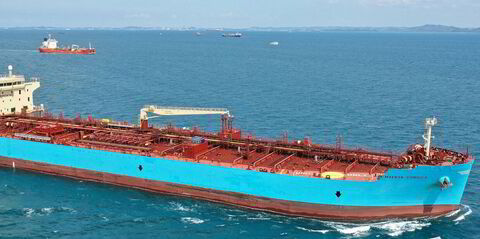In this episode of the GreenSeas podcast, TradeWinds technology editor Craig Eason visits a Chemship tanker while it was having suction sails installed in Rotterdam and talks to Chemship chief executive Niels Grotz about the decision to choose a wind system and other fuel-saving measures.
We also hear from the chief executives of two mechanical sail makers — Frank Nieuwenhuis of Econowind, whose systems are being installed on the Chemship vessel, and Norsepower’s Tuomas Riski about the need to expand production in China as demand ramps up.
Episode transcript
Craig Eason, TradeWinds:
Hi and welcome to this week’s episode of TradeWinds’ GreenSeas podcast, my name is Craig Eason, technology editor at TradeWinds and your host this week.
This episode is about one of the so-called new technologies that’s really begun to take off: wind propulsion.
Frank Nieuwenhuis, chief executive of Econowind:
“Always a little bending knees. But it’s amazing that, you know, I really in the beginning didn’t figure I would get to this stage. And after my career and now in this company, it’s really cool that you can do something worthwhile.
Eason:
We get to hear from two technology companies making inroads into the market and a shipowner who has very recently put four systems on board a vessel.
Niels Grotz, chief executive of Chemship:
I bumped into Frank Nieuwenhuis of Econowind, and he started to tell me about the sails, and being a sailor myself, I sort of fell in love with the idea. And that is really how it started.
Eason:
Wind technology is I would say becoming the technology of 2024. We are not even two months into the year and I have interviewed and spoken to at least five technology companies that will be in the coming months pushing on with trials, installing systems on existing ships and even winning orders to install systems on to newbuilding vessels.
Regular listeners to the podcast, or readers of technology or regulatory news on TradeWinds, will know how regulations are pushing shipping companies to look more favourably at new solutions to keep vessel emissions low — both on existing ships and those being built.
Later in this episode, we will hear from Norsepower, the Finnish company which announced what could be the single biggest order to date, to put 16 rotor sails onto three ships being built in China for Louis Dreyfus Armateurs.
Last week, I went to Rotterdam where a 16,100-dwt Chemship tanker, the Chemical Challenger, was finishing off the installation of four suction sails from fellow Dutch company Econowind.
Chemship chief executive Niels Grotz showed me round the ship.
Grotz (on board the Chemical Challenger):
We started this journey already three years ago, when I just looked at ways we can reduce the CO2 output on a vessel.
And that actually was already long before all of the new regulations came in.
I just did it because I thought, well, we have a young fleet, so we in a way we benefit from new engines and good ships. But I was just looking beyond that. How could I achieve that? And I just started to ask around mainly start-up companies, “How can you help me reducing the CO2?”
And I don’t know how, but I bumped into Frank Nieuwenhuis of Econowind and he started to tell me about the sails and being an avid sailor myself I sort of fell in love with the idea. And that is really how it started.
Eason (on board the Chemical Challenger):
What I can see here is four sails being installed, although they are not fully installed yet.
How difficult has it been to actually get them installed? I can see hydraulic systems being put in, electronic systems. I can see a lot of cabling. There seems to be a lot of work going on to put these four on board?
Grotz:
The work is actually much bigger than we envisioned when we shook hands to put the sails on board.
But I'm not regretting it, because I think we are going to achieve what we want to achieve, and that is to reduce the CO2.
The work has been tremendous. The ship has been in a shipyard in Bulgaria to do the pre-work. We’ve been here [in Rotterdam] all week.
But I think it’s worth every penny because I’m not looking at the money really, I’m looking at the CO2 reduction.
Eason:
I have noticed that this is not the only system that you’ve got going onto this year, I see a propeller boss cap fin going on to the propeller later today.
So, there is a range of systems that you’re going to be putting onto the ship. Is this something that you are also copying, or thinking to, copy onto the other vessels? Because you’ve got a fleet of about 15 ships?
Grotz:
Correct. We have 15 vessels and on most of them we have already applied small technical changes, where we just gain 1% to 3% of reduction in the in [fuel] consumption.
But this ship now has five systems.
So we have got the Econowind sails. We are working with a sustainable lube-oil manufacturer, also a start-up company in Holland, which we apply in the generators, where we get a 3% reduction in consumption and of course in CO2 emissions.
We are working with two different paint manufacturers for the underwater part of the ship — we apply paints which are so smooth that the ship is just gliding through the water.
We have the boss cap fin, as you mentioned, which we already have on two ships now.
And then we are also working on the motor management and working with torque meters on the shaft generator on the shaft, so we can measure what is happening in the engine and how can we manage the engine better.
Eason:
Altogether, this looks like it is a well thought out operation and we all know that there are regulations that are coming into play now.
We’ve got the CII [Carbon Intensity Indicator rating], which of course you’ll be looking at in your calculations to see how you rank on that with your vessels.
Also, next year, we’re going to have the FuelEU Maritime, so every time this ship comes into Europe, it’s going to have to comply with that, of course to the ETS [European Union Emissions Trading System] as well.
But just sticking with the CII and the Fuel EU maritime, because particularly that latter, you can pool your vessels.
This I’m going to guess, by having the rotors on board is going to enable your whole fleet then to be pooled. Is that one of your ideas?
Grotz:
Well, firstly, we operate a fleet of 15 ships, and we have an average age of seven.
So if you look at, at the CII, we’re scoring pretty high, and also as a pool.
I think this can be a really interesting voyage with the sails. And the results we can see on this first voyage will really determine what we can do in the future with the sails on the other ships.
We have an option for four other sails to be installed on a sister ship of the Chemical Challenger.
The success will be when we measure on our transatlantic voyage to Houston then we will know what route we can to take when it comes to the sails, but I have good hopes.
Eason:
Finally, in terms of image, putting four sails like this onto a ship, on any ship really, for me, indicates symbolically, as well as practically, a visible indication of the transition that we’re going through in this industry from 30 years ago.
Grotz:
The visual image of a ship coming in with sails, for me brings back memories, because at the end of the day, shipping started with sails.
Shipping is evolving all the time. And having the sails now on board will really show the industry that it is possible to use wind again.
And what I really also like about this project is that the routes Chemship sails on, we’re calling a lot of old ports, ports like Istanbul, Genoa and Naples — all 2,500-year-old and they’ll be amazing when a ship sails in a port like that.
Eason:
Niels Grotz, Chemship chief executive talking to me while we walked around the Chemical Challenger, watching the last of the four suction sails from Econowind get lifted and secured on board.
Grotz was both excited about the journey, and, being an ex-seafarer, nervous about putting the systems through their paces as the ship sails across the North Atlantic.
And it is this seaworthiness of any cleantech on board a ship that would keep any shipping boss awake. Ships do not look good limping into port.
This is something the technology companies will also be aware of, and when I spoke to Econowind chief executive Frank Nieuwenhuis he said they have taken this into account as they improved the design of their suction sail.
Eason:
As we’re watching the fourth of the sails being lowered onto the deck to be installed onto the Chemical Challenger, with me is Frank Nieuwenhuis, chief executive of Econowind.
This is the fourth system here that is going on board, but how many systems have you actually got on board other ships at the moment?
Nieuwenhuis (on board the Chemical Challenger):
In total about 16 wings, but it is a little bit how you count, because some of them are containers, and they have been placed from one ship to another in a rental construction.
But in retrofit installation, now 12 on seven ships.
Eason:
How does it actually work? I noticed that these are slightly different from the original set-up that I saw from Econowind, which had, I believe, a flap at the back that has been evolved. What’s the basic principle of how these systems work?
Nieuwenhuis:
Well, as a suction wing you need suction on one side and therefore there was a flap which changed from one side to the other in the first systems that was an exact copy of what was done previously in the 1980s.
We figured out a way to get away from that moveable flap, because at sea, everything that moves breaks down.
We figured a way to get away from the movable flap, but then a different smart way of doing the suction, we can now do the suction with the fixed flap in the rear.
Eason:
I noticed it takes a little bit of installation because there’s these base points that have had to be built onto the ship upon which the systems are going to be installed.
They are foldable so that they can be lowered down if the weather is rough or needs to be during port operations, or the harbour requires it, etc.
How have you devised the system to be as efficient as possible so that it can work as effectively as possible?
Nieuwenhuis:
Well, if you mean, once it’s been installed, and then really it’s the concept of the suction wing.
A normal wing would be much bigger in order to have a certain force, and to stabilise the airflow, we use the suction system.
So, we kind of pull the wind around the wing. Now we can have a thick nose, which gives a high force and yet still have a small chord length, and that’s really the function of the suction.
I won’t go into the details how it works, but the suction really means that you can keep a somewhat smaller wing having the same force, as when you do not have the suction then you need a bigger wing.
Eason:
I got told that when you came up with this idea a few years ago, I’m not sure when, but somebody told me that you towed a version of this behind a car.
Nieuwenhuis:
(Laughing) That’s very true.
Conoship had been studying all the concepts of wind-assisted system ship propulsion, so they looked at rotors, at kites, normal sails, normal wings and also at suction wings.
Once they were ready with a studying, they wanted to go into the wind tunnel and build a model to prove it and to get your own feeling for it.
Getting into the wind tunnel is quite expensive and difficult if you don’t have a company yet. And indeed, I met Conoship and then, and I said, “Well, why don’t you put one behind your car in a relatively wind-free day, then the relative speed is the same, so it’s comparable.”
And that’s what we did. We actually put first a small one on top of my car, and then we had a trailer and we pulled a five-metre wing on a beautiful nice day and did our force measurements and found out that the concept indeed is very good.
Eason:
Just finally, every time you see one of these systems get put onto the ship. How do you feel?
Nieuwenhuis:
It’s amazing. Always a little bendy in the knees, but it is amazing.
I really, in the beginning, didn’t figure I would get to this stage, and after my career, and now in this company, it’s really cool that you can do something worthwhile.
Eason:
That is Frank Nieuwenhuis, chief executive of Econowind talking to me about the journey he and Econowind have gone down in the last eight years to get a technology ready.
Econowind is not the only technology doing well off the growing acceptance of the wind technology systems and the shipowner and operator concern about the regulatory landscape.
Another company is Finland’s Norsepower. It has also grown its position since emerging with an early installation of a Flettner rotor on the Maersk Pelican six years ago.
While Econowind has a suction sail, Norsepower’s system is based on the Flettner rotor.
The suction sail idea has evolved from the sail design by Jacques Cousteau back in the 1980s, while the Norsepower rotor sails are based on an invention from German inventor and engineer Anton Flettner about 100 years ago.
Well, a century after its invention, it seems to be getting its moment.
While Econowind is ramping up production of its suction sails in the Netherlands for both its existing sail system and a much larger design it has for bigger ships, so Norsepower is ramping up production in China.
Here’s Norsepower chief executive Tuomas Riski.
Tuomas Riski, chief executive, Norsepower:
We are ramping up our factory in China. It is north from Shanghai, at the city of Dafeng. We are building, I think, the first-ever mechanical sail factory in the world and when it’s ready we are aiming for production capacity of 100 rotor sails per year from that Dafeng factory.
Eason:
The presence in China is certainly with the newbuilding market in mind and Tuomas Riski agreed that it is the regulations driving interest from owners, but also there’s a business case
Riski:
It is of course always the end customer, the ship owner and or the charter who is deciding that they want to have rotor sails on board.
But quite often, if it is a new build case, we are selling the rotor sails to a shipyard and we are more and more partnering with Asian shipyards and we are actively looking for new shipyard partners throughout.
Eason:
As a naval architect will note, ship designs today have not been optimised for the wind, that was back in the day of the tea clippers.
The sleek sailing hulls have become more box-like to maximise cargo carrying capacity, such as you find with a modern bulk carrier or tanker.
If a newbuilding is going to have a wind propulsion system installed, the design can be optimised. Here is Tuomas Riski again.
Riski:
Yes, that is the case. You can maximise the benefits by doing that.
It is not only the hull form. It is also the locations for the rotor sails, they can be optimised. And also the main propulsion, or conventional propulsion, system can be designed so that it can be adapted to variable load from the mechanical sails in an optimal way.
Eason:
That is Thomas Riski from Finnish rotor sail maker Norespower.
Now before we end, if you listened to last week’s episode you will have heard my colleague Eric Priante Martin discuss the cause of a horrendous oil spill in South America, with fingers being pointed at a Vietnamese-owned, Panama-flagged, vessel.
Here’s Eric with a quick update.
Eric Priante Martin, TradeWinds
A few weeks ago we reported on an oil slick off Brazil that covered a 170-square-km area of the Atlantic, and how SkyTruth believes the source of that spill could be a chemical tanker called the PVT Sunrise.
We have now heard back from PetroVietnam, the Vietnamese oil company that owns that vessel. Its shipping unit, Petrovietnam Transportation Hanoi, said it conducted an internal investigation and rejected its ship could have been responsible for the oil slick.
The company said the ship was in ballast at the time.
That means it was carrying no cargo and there is no record of any discharge of oil from the ship, and the company said it’s not been contacted by Brazilian authorities.
Eason:
Well that is it for this week’s episode of the TradeWinds’ GreenSeas podcast. If you go to the podcast website we will put links to the relevant news stories covered in this episode.
And remember to subscribe to the podcast in whatever podcast platform you use … you know, Apple, Google, YouTube, Soundcloud, Podbean or Spotify.
There’s something for all tastes.
You can also sign up for the GreenSeas newsletter.
So that’s it for this week, I am Craig Eason. Goodbye.



